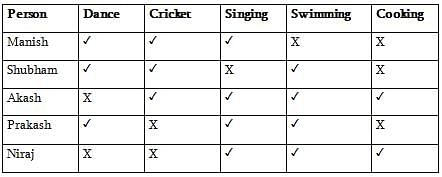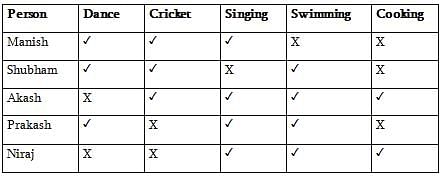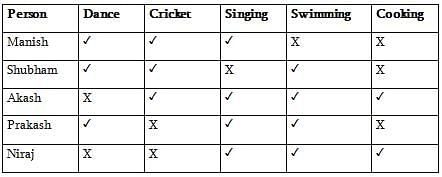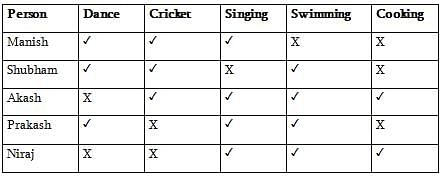HPPSC HPAS Prelims Paper 2 Mock Test - 8 - HPPSC HPAS (Himachal Pardesh) MCQ
30 Questions MCQ Test HPPSC HPAS Mock Test Series 2025 - HPPSC HPAS Prelims Paper 2 Mock Test - 8
Correct the given equations by interchanging the two signs (10 - 14 ÷7 x 3 + 4 = 20)
What is the primary purpose of the Yuva Aapda Mitra Scheme (YAMS) as approved by the committee?
Which of the following states is NOT included in the projects approved for urban flood management?
What are the four priority actions outlined in the Sendai Framework for Disaster Risk Reduction?
What does Disaster Risk Reduction (DRR) aim to achieve?
Which act established the National Disaster Management Authority (NDMA) in India?
What was India's rank in the World Economic Forum (WEF) report of 2024 regarding the global gender gap in education?
What is the gross enrollment ratio (GER) for women in higher education according to the AISHE report for 2021-22?
Look at this series: 53, 53, 40, 40, 27, 27,...so on. What number should come next?
Given below is an inequality, which of the following condition is TRUE?
If A > B > C > D = F ≥ G < H
Select the correct set of symbols which will fit in the given equation 5 0 6 8 = 48
Direction for: Each of the following questions is based on the following information:
1. Six flats on a floor in two rows facing North and South are allotted to P, Q R, S, T and U.
2. Q gets a North facing flat and is not next to S.
3. S and U get diagonally opposite flats.
4. R next to U, gets a south facing flat and T gets North facing flat.
If the flats of P and T are interchanged then whose flat will be next to that of U?
Direction for: Each of the following questions is based on the following information:
1. Six flats on a floor in two rows facing North and South are allotted to P, Q R, S, T and U.
2. Q gets a North facing flat and is not next to S.
3. S and U get diagonally opposite flats.
4. R next to U, gets a south facing flat and T gets North facing flat.
Which of the following combinations get south facing flats?
Direction for: Each of the following questions is based on the following information:
1. Six flats on a floor in two rows facing North and South are allotted to P, Q R, S, T and U.
2. Q gets a North facing flat and is not next to S.
3. S and U get diagonally opposite flats.
4. R next to U, gets a south facing flat and T gets North facing flat.
The flats of which of the other pairs than SU, is diagonally opposite to each other?
India is rushing headlong towards economic success and modernisation, counting on high- tech industries such as information technology and biotechnology to propel the nation to prosperity. India’s recent announcement that it would no longer produce unlicensed inexpensive generic pharmaceuticals bowed to the realities of the World Trade Organisation while at the same time challenging the domestic drug industry to compete with the multinational firms. Unfortunately, its weak higher education sector constitutes the Achilles heel of this strategy. India’s main competitors especially China but also Singapore, Taiwan, and South Korea are investing in large and differentiated higher education systems. They are providing access to large numbers of students at the bottom of the academic system while at the same time building some research based universities that are able to compete with the world’s best institutions. There are a small number of high quality institutions, departments, and centres that can form the basis of the quality sector in higher education. India Educates approximately 10 percent of Its young people in higher education compared with more than half in the major industrialized countries and 15 percent in China. Almost all of the world’s academic systems resemble a pyramid, with a small high quality tier at the top and massive sector at the bottom. India has a tiny top tier. None of its universities occupies a solid position at the top. A few of the best universities have some excellent departments and centres, and there are a small number of outstanding undergraduate colleges.
Q. By what measures can you say that the Asian countries, other than India, are heading towards a knowledge based economy?
1. Building competitive research based universities.
2. Investing in diverse higher education systems,
3. Providing access to higher education to a select few students.
India is rushing headlong towards economic success and modernisation, counting on high- tech industries such as information technology and biotechnology to propel the nation to prosperity. India’s recent announcement that it would no longer produce unlicensed inexpensive generic pharmaceuticals bowed to the realities of the World Trade Organisation while at the same time challenging the domestic drug industry to compete with the multinational firms. Unfortunately, its weak higher education sector constitutes the Achilles heel of this strategy. India’s main competitors especially China but also Singapore, Taiwan, and South Korea are investing in large and differentiated higher education systems. They are providing access to large numbers of students at the bottom of the academic system while at the same time building some research based universities that are able to compete with the world’s best institutions. There are a small number of high quality institutions, departments, and centres that can form the basis of the quality sector in higher education. India Educates approximately 10 percent of Its young people in higher education compared with more than half in the major industrialized countries and 15 percent in China. Almost all of the world’s academic systems resemble a pyramid, with a small high quality tier at the top and massive sector at the bottom. India has a tiny top tier. None of its universities occupies a solid position at the top. A few of the best universities have some excellent departments and centres, and there are a small number of outstanding undergraduate colleges.
What did India agree to do at the behest of the World Trade Organisation?
India is rushing headlong towards economic success and modernisation, counting on high- tech industries such as information technology and biotechnology to propel the nation to prosperity. India’s recent announcement that it would no longer produce unlicensed inexpensive generic pharmaceuticals bowed to the realities of the World Trade Organisation while at the same time challenging the domestic drug industry to compete with the multinational firms. Unfortunately, its weak higher education sector constitutes the Achilles heel of this strategy. India’s main competitors especially China but also Singapore, Taiwan, and South Korea are investing in large and differentiated higher education systems. They are providing access to large numbers of students at the bottom of the academic system while at the same time building some research based universities that are able to compete with the world’s best institutions. There are a small number of high quality institutions, departments, and centres that can form the basis of the quality sector in higher education. India Educates approximately 10 percent of Its young people in higher education compared with more than half in the major industrialized countries and 15 percent in China. Almost all of the world’s academic systems resemble a pyramid, with a small high quality tier at the top and massive sector at the bottom. India has a tiny top tier. None of its universities occupies a solid position at the top. A few of the best universities have some excellent departments and centres, and there are a small number of outstanding undergraduate colleges.
Which of the following are India’s weaknesses when it comes to higher education?
1. Indian universities do not have the requisite teaching faculty to cater to the needs of the higher education sector.
2. Only five Indian universities occupy the top position very strongly, in the academic pyramid, when it comes to higher education.
3. India has the least percentage of young population taking to higher education as compared to the rest of the comparable countries.
Virtually everything astronomers known about objects outside the solar system is based on the detection of photons—quanta of electromagnetic radiation. Yet there is another form of radiation that permeates the universe: neutrinos. With (as its name implies) no electric charge, and negligible mass, the neutrino interacts with other particles so rarely that a neutrino can cross the entire universe, even traversing substantial aggregations of matter, without being absorbed or even deflected. Neutrinos can thus escape from regions of space where light and other kinds of electromagnetic radiation are blocked by matter. Furthermore, neutrinos carry with them information about the site and circumstances of their production: therefore, the detection of cosmic neutrinos could provide new information about a wide variety of cosmic phenomena and about the history of the universe.
With which of the following statements regarding neutrino astronomy would the author be most likely to agree?
Virtually everything astronomers known about objects outside the solar system is based on the detection of photons—quanta of electromagnetic radiation. Yet there is another form of radiation that permeates the universe: neutrinos. With (as its name implies) no electric charge, and negligible mass, the neutrino interacts with other particles so rarely that a neutrino can cross the entire universe, even traversing substantial aggregations of matter, without being absorbed or even deflected. Neutrinos can thus escape from regions of space where light and other kinds of electromagnetic radiation are blocked by matter. Furthermore, neutrinos carry with them information about the site and circumstances of their production: therefore, the detection of cosmic neutrinos could provide new information about a wide variety of cosmic phenomena and about the history of the universe.
According to the passage, one advantage that neutrinos have for studies in astronomy is that they
In which direction is A from B?
Statement- (1) C is in the South from B which is in the West of A.
Statement- (2) B and D is in a straight line and D is in the South from A.
Directions: Symbols %, #, $, © are used with different meanings as explained below:
‘P @ Q’ means ‘P is not greater than Q’.
‘P % Q’ means ‘P is neither greater than nor equal to Q’.
‘P # Q’ means ‘P is neither smaller than nor equal to Q’.
‘P $ Q’ means ‘ P is neither smaller than nor greater than Q’ .
‘P © Q’ means ‘P is not smaller than Q’.
Three statements showing relationships have been given, which are followed by two conclusions (1) and (2). Assuming that the given statements are true, find out which conclusions(s) is/are definitely true.
Statements — M $ K, K © F, F % H. Conclusions—
1. M # F
2. M $ F
Directions: Study the following information carefully and answer the questions that follow.
Manish and Shubham are good in Dance and Cricket. Akash and Manish are good in Cricket and Singing. Akash, Prakash and Niraj are good in Singing and Swimming. Niraj and Akash are good in Singing and Cooking. Prakash and Shubham are good in Swimming and Dance.
Who is good in Cricket, Swimming and Dance?
Directions: Study the following information carefully and answer the questions that follow.
Manish and Shubham are good in Dance and Cricket. Akash and Manish are good in Cricket and Singing. Akash, Prakash and Niraj are good in Singing and Swimming. Niraj and Akash are good in Singing and Cooking. Prakash and Shubham are good in Swimming and Dance.
Who is good in Singing, Dance and Cricket?
Directions: Study the following information carefully and answer the questions that follow.
Manish and Shubham are good in Dance and Cricket. Akash and Manish are good in Cricket and Singing. Akash, Prakash and Niraj are good in Singing and Swimming. Niraj and Akash are good in Singing and Cooking. Prakash and Shubham are good in Swimming and Dance.
Who is good in Singing, Swimming and Dance?
Directions: Study the following information carefully and answer the questions that follow.
Manish and Shubham are good in Dance and Cricket. Akash and Manish are good in Cricket and Singing. Akash, Prakash and Niraj are good in Singing and Swimming. Niraj and Akash are good in Singing and Cooking. Prakash and Shubham are good in Swimming and Dance.
Who is good in Singing, Swimming and Cooking but not in Cricket?
Despite the best efforts of those responsible for preventing fraud, one inevitable reality remains: “fraud happens.” Because fraud and misconduct can occur at various levels in any organization, it is essential that appropriate preventive and detective techniques are in place. Although fraud prevention and detection are related concepts, they are not the same. While prevention encompasses policies, procedures, training, and communication, detection involves activities and programs designed to identify fraud or misconduct that is occurring or has occurred. Although preventive measures cannot ensure that fraud will not be committed, they are the first line of defence in minimizing fraud risk. One key to prevention is making personnel throughout the organization aware of the fraud risk management program, including the types of fraud and misconduct that may occur. This awareness should enforce the notion that all of the techniques established in the program are real and will be enforced. The ongoing communication efforts could provide information on the potential disciplinary, criminal, and civil actions that the organization could take against the individual. With this in mind, prevention and deterrence are interrelated concepts. If effective preventive controls are in place, working, and well-known to potential fraud perpetrators, they serve as strong deterrents to those who might otherwise be tempted to commit fraud. Fear of getting caught is always a strong deterrent. Effective preventive controls are, therefore, strong deterrence controls.
How the HR department of an organization can play a vital role in the prevention of fraud in the company?
Despite the best efforts of those responsible for preventing fraud, one inevitable reality remains: “fraud happens.” Because fraud and misconduct can occur at various levels in any organization, it is essential that appropriate preventive and detective techniques are in place. Although fraud prevention and detection are related concepts, they are not the same. While prevention encompasses policies, procedures, training, and communication, detection involves activities and programs designed to identify fraud or misconduct that is occurring or has occurred. Although preventive measures cannot ensure that fraud will not be committed, they are the first line of defence in minimizing fraud risk. One key to prevention is making personnel throughout the organization aware of the fraud risk management program, including the types of fraud and misconduct that may occur. This awareness should enforce the notion that all of the techniques established in the program are real and will be enforced. The ongoing communication efforts could provide information on the potential disciplinary, criminal, and civil actions that the organization could take against the individual. With this in mind, prevention and deterrence are interrelated concepts. If effective preventive controls are in place, working, and well-known to potential fraud perpetrators, they serve as strong deterrents to those who might otherwise be tempted to commit fraud. Fear of getting caught is always a strong deterrent. Effective preventive controls are, therefore, strong deterrence controls.
What is the strong deterrent for fraud according to this passage?
One year ago, the ratio between Rajeev’s salary and Shivani’s salary is 4:5. The ratio between their individual salary of the last year and current year is 2:5 and 10: 11 respectively. If the total current salary of Rajeev and Shivani is 6200. Then find the current salary of Shivani?
There is a Hockey match of Dhyanchand tomorrow, at Motera stadium. In recent years, it has rained only 73 days each year. Unfortunately, the weatherman has predicted rain for tomorrow. When it actually rains, the weatherman correctly forecasts rain 80 of the time. When it doesn't rain, he incorrectly forecasts rain 20 of the time. What is the probability that it will rain on the day of Dhyanchand's Hockey match?
Study the following table and answer the question based on it.
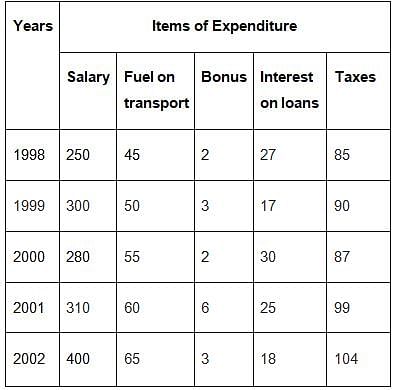
Expenditures of a Company (in Lakh Rupees) per Annum Over the given Years
The total amount of bonus paid by the company during the given period is approximately what percent of the total amount of salary paid during this period?









